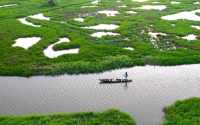1 October 2007
When the Neolithic farmers and hunters of Skara Brae first built their stone houses on Orkney, they were careful to place their settlement more than a mile from the coast to avoid their homes being pounded by the harsh winter storms that sweep across the Bay of Skaill.
Some 5,000 years later, the custodians of Europe's most complete prehistoric village no longer have the luxury of land to shelter them from the sea. Slowly but surely, erosion has brought the sea ever closer to the grey rock-built dwellings and now spray from the wind-whipped Atlantic regularly soaks the World Heritage Site.
A concrete seawall built in 1926 to protect Skara Brae is crumbling and before too long the water will break through the dunes and flow behind this archaeological treasure, in effect turning it into an island and putting it at greater danger from the encroaching tides. Such is the scale of the risk to the site that its managers have even discussed moving it stone by stone inland.
But while Skara Brae is so popular and so internationally important that every effort will be made to try to ensure its preservation, it is just one of many thousands of historic structures and buildings on Britain's coast that are at risk of being destroyed by erosion, storms and rising sea levels caused by climate change.
Conservationists yesterday warned many of these locations, including unexamined archaeological sites such as ancient shipwrecks and old settlements, will be lost because of a lack of resources or time to carry out excavations and the destructive power of the sea. It is estimated that sea levels could rise by about a metre by the end of this century due to global warming, and the coastline is receding by nearly two metres a year in some areas.
The result is a race against time to discover and document as many of these seaside landmarks – which range from a Roman cemetery in Cumbria to pillboxes on the Suffolk coast – as possible.
A study in Scotland published last week estimated that 10,000 ancient or historical sites on the Scottish coastline are at risk, including Viking burial boats, Iron Age roundhouses and Bronze Age rubbish mounds. A similar project is urgently being conducted by English Heritage and the National Trust to map and catalogue thousands of endangered coastal structures in England and Wales. Where necessary, "emergency" archaeological digs will be ordered to record sites and recover artefacts before they disappear beneath the waves.
Stephen Trow, head of rural and environmental policy for English Heritage, said: "Traditionally the coast has been very poorly researched from an archaeological point of view because it is hostile terrain where it can be extremely difficult to work. But the survey work has already shown a substantial increase in the number of sites we know about.
"Where they are in settled areas, they will benefit from existing sea defences but in areas of rural coastline the policy is more likely to be to allow the sea to reach its natural level. There will come a point at which we will have to decide which sites to defend and which we will simply lose."
In some places the loss of ancient material is already happening. On Orkney, which has more than 500 archaeological landmarks, parts of Bronze Age forts have been washed into the sea, skeletons have been swept from Iron Age burial chambers, and a section of a Viking grave ship uncovered by a winter storm in the early 1990s has vanished. Experts point out that the coast, more often than not the first part of a landmass to be settled, is rich in evidence of human activity over millennia which remains undiscovered or unexamined. Alongside submerged prehistoric forests, there are myriad wooden structures that have been barely documented such as causeways, fish weirs, burial buildings, clay huts used to refine salt, oyster pits and shipwrecks.
Tom Dawson, an archaeologist at the University of St Andrews, said: "This is a uniquely valuable and totally irreplaceable part of the nation's cultural heritage, with much still to teach us about our past. While people argue over whether climate change is leading to sea-level rise and an increase in stormy weather, the coast continues to erode. Although wildlife and the natural habitat may be able to recover, ancient sites will be destroyed for ever and the remnants of our ancestors will be lost."
In order to combat the problem, Mr Dawson manages Scottish Coastal Archaeology and the Problem of Erosion (Scape), a group set up in 2001 to protect ancient coastal sites. The organisation announced this month that it had identified 3,500 archaeological locations at risk of destruction after surveying less than a third of the Scottish coastline. It is estimated that more than 10,000 sites will be classified as being at risk once the study is complete.
They include prehistoric ruins at Jarlshof, a settlement on the southern tip of Shetland which includes Pictish houses and Viking longhouses, and Lochranza Castle, a medieval castle on the shoreline on the Isle of Arran.
Elsewhere in Britain, the sea is being allowed to do its work on sites already considered beyond preservation. A Roman cemetery discovered in 1879 in the sand dunes at Beckfoot in Cumbria will soon be washed away and Blakeney Chapel, a medieval church and scheduled ancient monument on the Norfolk coast, is described by English Heritage as facing "inevitable destruction". The National Trust, which estimates that 60 per cent of the coastline it owns will be affected by erosion by 2010, has decided to surrender huts on Studland peninsula in Dorset to the waves and relocate others, including its beach cafe.
In some cases, the buildings at risk are considered worth saving, even if it is at considerable cost. Engineers are waiting to start work on a project to save Clavell Tower, an observatory and folly built on a crumbling cliff top overlooking Kimmeridge Bay in Dorset. Constructed in 1830 by a local vicar, it was the inspiration for the detective novel The Black Tower, by PD James, who has backed the campaign to save it.
It was also one of the places where Thomas Hardy courted his first love, Eliza Nicholl, and he used a picture of it as a frontispiece for his Wessex Poems. The Landmark Trust has raised £714,000, some of it from the Heritage Lottery fund, to move the building 25 metres inland by dismantling it brick by brick.
Managers of Skara Brae are considering a scheme to build a new larger sea wall but admit they will struggle to find the necessary funding in Orkney and have called for the Government dramatically to increase the amount it spends on archaeological "rescue". Whatever the outcome, the high price of such projects means they are likely to be few and far between.
Indeed, archaeologists are having to stretch budgets to deal with another, more positive, aspect of coastal erosion – the fact that extreme weather can uncover new finds just as quickly as it destroys them.
A violent storm in the Western Isles of Scotland two years ago destroyed a picnic and car park on the Baile Sear beach on the island of North Uist. It also washed away sand and soil which had been concealing a mass of archaeological material, including pottery, animal bones, chunks of masonry and a prehistoric waste dump.
A team of volunteers and archaeologists has been working on the island this summer to examine and record the finds before they are washed away by another storm.
Conservationists say there are dozens of similar cases around the British coast where the shifting sands have revealed their long-hidden remains. Among the recent new finds are two shipwrecks on the Lincolnshire coast, one of them an "ice ship" which sailed between Grimsby and Norway collecting ice for the fishing industry and was wrecked in 1901. Submerged forests, a medieval saltworkings and fields have also been exposed and then covered again by the shifting tides in recent years. But archaeologists complain that in many cases the funds and the time are not available to allow close examination of the finds. Steve Catney, Lincolnshire's principal archaeologist, said: "All our time is taken up by development control work. Sites usually appear and disappear quickly and we rarely have the time or resources to do anything about them."
The hope is that knowledge of many coastal sites will be at least preserved by meticulously recording and documenting their details rather than saving the structures themselves. Others have pointed to the success of an "adopt a monument" campaign in Scotland whereby volunteers are encouraged to examine endangered sites under the supervision of an expert.
But it is hard to escape the sense that the past is disappearing with the coming of every tide. Julie Gibson, of the Orkney Archaeological Trust, which manages Skara Brae and the islands' myriad ancient sites, said: "Archaeology is a non-renewable resource. You get one shot at learning from it and when it goes, it is gone for ever."






